Konstantin Grcic’s ’Hieronymus’ pushes the boundries of form and function

To understand how Konstantin Grcic arrived at his latest series, 'Hieronymus', you must refer to the painting by Antonello da Messina of Saint Jerome in his study. In it, the theologian and Doctor of the Church, most recognised for translating the Bible into Latin, is situated on a podium rendered with architectural elements like a proscenium-cum-office.
Flash forward roughly 500 years when Grcic was training as a cabinetmaker in Dorset where he first saw a photo of the work, exhibited in the National Gallery, and marveled at this unusual depiction of furniture. His five pieces currently presented at the Galerie Kreo adopt this workstation concept circa 1475 while radically rethinking the design for today.
Within the Paris gallery, the varyingly geometric works give the impression of sculptures, whether cube-like in Carrara marble, tube-like in gold matte-finish aluminum, ovoid in 3D-printed sand, or irregularly pentagonal in fibre-cement. But the German designer – also currently showing a selection of plinth designs at the Kunsthalle Bielefeld – says he never considered the pieces as unoccupied. ‘Even in our early visualisations and illustrations, there was always a person inside,’ he tells Wallpaper*, demonstrating how each invites a slightly different posture.
More than just striking forms, the units serve as self-contained spaces for reading, writing or else the oft-neglected art of contemplation. Grcic points out how occupying one offers a reminder that furniture engages multiple points of contact: how we sit, where we place our feet, whether we can easily rest our elbows. ‘You can argue, “Is it comfortable or is it uncomfortable?” I think it’s both; it depends very much on your frame of mind and what you want to do,’ he says, before adding they are not intended as ‘9-to-5 desks.’
Grcic notes, too, how these ‘proposals’ present different typologies to the standard chair and table within a small footprint. The uprightness of the aluminum design, for instance, has the effect of a minimalist throne, while the larger 3D design could accommodate several people like space-age, tête-à-tête
-style seating.
Unlike some of his industrial designs, Grcic says conceiving a series for Galerie Kreo allows him to test the limits of form and function. ‘The gallery is the kind of oratory or playground for trying things out. When you find things that work, they could end up being used in a commercial project. But I think you have to go extreme in order to learn a lot,’ he says.
Still to be determined is whether the pieces themselves might enable different ways of thinking—that leaning on the bench within the fibre-cement structure could stimulate ideas that wouldn’t materialise from sitting in the back of a taxi. To this, Grcic replies, ‘I think this is most significant; any chair has an effect on mind and how you work. Some people can concentrate anywhere, like in an airport. But here, I think the physical interaction puts you into a space which is also a mental space.’
Without doubt, it’s also a contemporary space, which he believes relates it back to the da Messina tableau ('Hieronymus' is Jerome in Latin). 'I think it’s something very much of today, just as much as the painting depicted how someone would think about Jerome in his study at that time,’ Grcic explains. ‘I couldn’t have done these five years ago and maybe I wouldn’t do them in five years’ time.’

Adopting the workstation concept circa 1475 depicted in a painting by Antonello da Messina of Saint Jerome, Grcic has radically reinterpreted the design for today. Pictured: '3D'
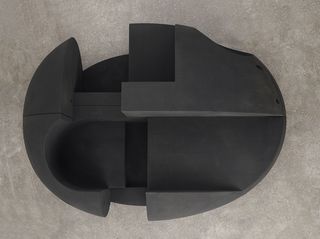
The varyingly geometric works at times seem more like sculptures, but they are more than just striking forms... Pictured: '3D' as seen from above

The units serve as self-contained spaces for reading, writing or else the oft-neglected art of contemplation

Grcic points out how occupying one offers a reminder that furniture engages multiple points of contact: how we sit, where we place our feet, whether we can easily rest our elbows. Pictured left: Wood. Pictured right: Minero
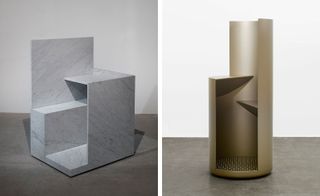
These ‘proposals’ present different typologies to the standard chair and table. The uprightness of the aluminum design, for instance, has the effect of a minimalist throne, while the larger 3D design could accommodate several people like space-age, indiscret-style seating. Pictured left: Marble. Pictured right: Metal
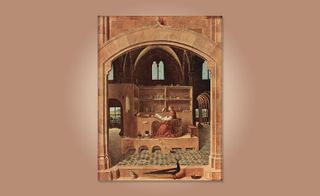
In Antonello da Messina's painting of Saint Jerome in his study, pictured, the theologian and Doctor of the Church, most recognised for translating the Bible into Latin, is situated on a podium rendered with architectural elements like a proscenium-cum-office. Photography courtesy of The National Gallery, London
INFORMATION
’Hieronymus’ is on view until 16 July. For more information visit the Galerie Kreo website
ADDRESS
31 rue Dauphine, 75006, Paris
Wallpaper* Newsletter
Receive our daily digest of inspiration, escapism and design stories from around the world direct to your inbox
-
 Fernando Jorge’s fluid diamond earrings show his curve appeal
Fernando Jorge’s fluid diamond earrings show his curve appealDiscover Brazilian jewellery designer Fernando Jorge's snake-like silhouettes and graphic shapes
By Hannah Silver Published
-
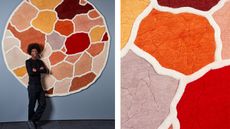 Abreham Brioschi debuts Ethiopia-inspired rugs for Nodus
Abreham Brioschi debuts Ethiopia-inspired rugs for NodusAbreham Brioschi teams up with luxury rug experts Nodus to translate visions from his heritage into a tactile reality
By Ifeoluwa Adedeji Published
-
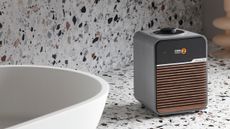 Five compact DAB radios that combine broadcast content with visual brio
Five compact DAB radios that combine broadcast content with visual brioThe latest DAB radios – countertop and bedside broadcast companions – for those who like their devices to be standalone and visually simple
By Jonathan Bell Published
-
 Ozone and Dominique Perrault Architecture create a series of monumental aluminium lamps
Ozone and Dominique Perrault Architecture create a series of monumental aluminium lampsOzone worked with Dominique Perrault and his partner Gaëlle Lauriot-Prévost to present the ‘Furtiv’ collection, featuring a series of aluminium lamps inspired by the architect's Bibliothèque François-Mitterrand in the 1990s
By Amy Serafin Published
-
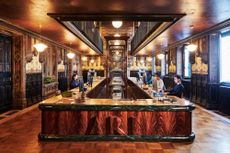 Is this the most beautiful office in the world?
Is this the most beautiful office in the world?Parisian creative agency Art Recherche Industrie’s new HQ translates a 19th-century landmark into a chic open-plan office worth leaving home for
By Rosa Bertoli Published
-
 Mono Editions launches furniture in cork and paper pulp
Mono Editions launches furniture in cork and paper pulpLaunched with a pop-up in Paris (23-27 March 2022), Mono Edition presents modular designs by architects, crafted from sustainable single materials
By Rosa Bertoli Last updated
-
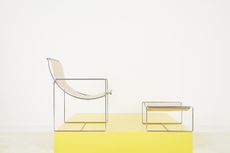 Odile Mir’s granddaughter is reissuing her 1970s French furniture
Odile Mir’s granddaughter is reissuing her 1970s French furnitureParisian designer Léonie Alma Mason launches LOMM Editions – a new brand presenting 1970s furniture designs created by her grandmother, nonagenarian artist Odile Mir
By Rosa Bertoli Last updated
-
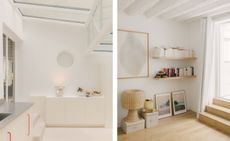 Historic Paris apartment gets wrapped in soft minimalism
Historic Paris apartment gets wrapped in soft minimalismArchitect Saba Ghorbanalinejad reworks the historic architecture of this Le Marais apartment for the 21st century
By Ellie Stathaki Last updated
-
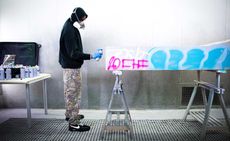 Galerie Kreo presents new furniture collection by Virgil Abloh
Galerie Kreo presents new furniture collection by Virgil AblohVirgil Abloh debuts major furniture collection for Paris' Galerie Kreo, focusing on concrete and the expression of the street
By Katie Meston Published
-
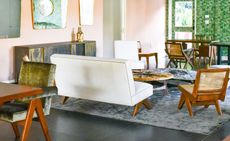 Pierre Jeanneret’s midcentury designs for Chandigarh get an LA audience
Pierre Jeanneret’s midcentury designs for Chandigarh get an LA audienceBy Ali Pechman Published
-
 French designer Marlène Huissoud creates silkworm cocoon set with London Bronze Casting
French designer Marlène Huissoud creates silkworm cocoon set with London Bronze CastingBy Rosa Bertoli Last updated